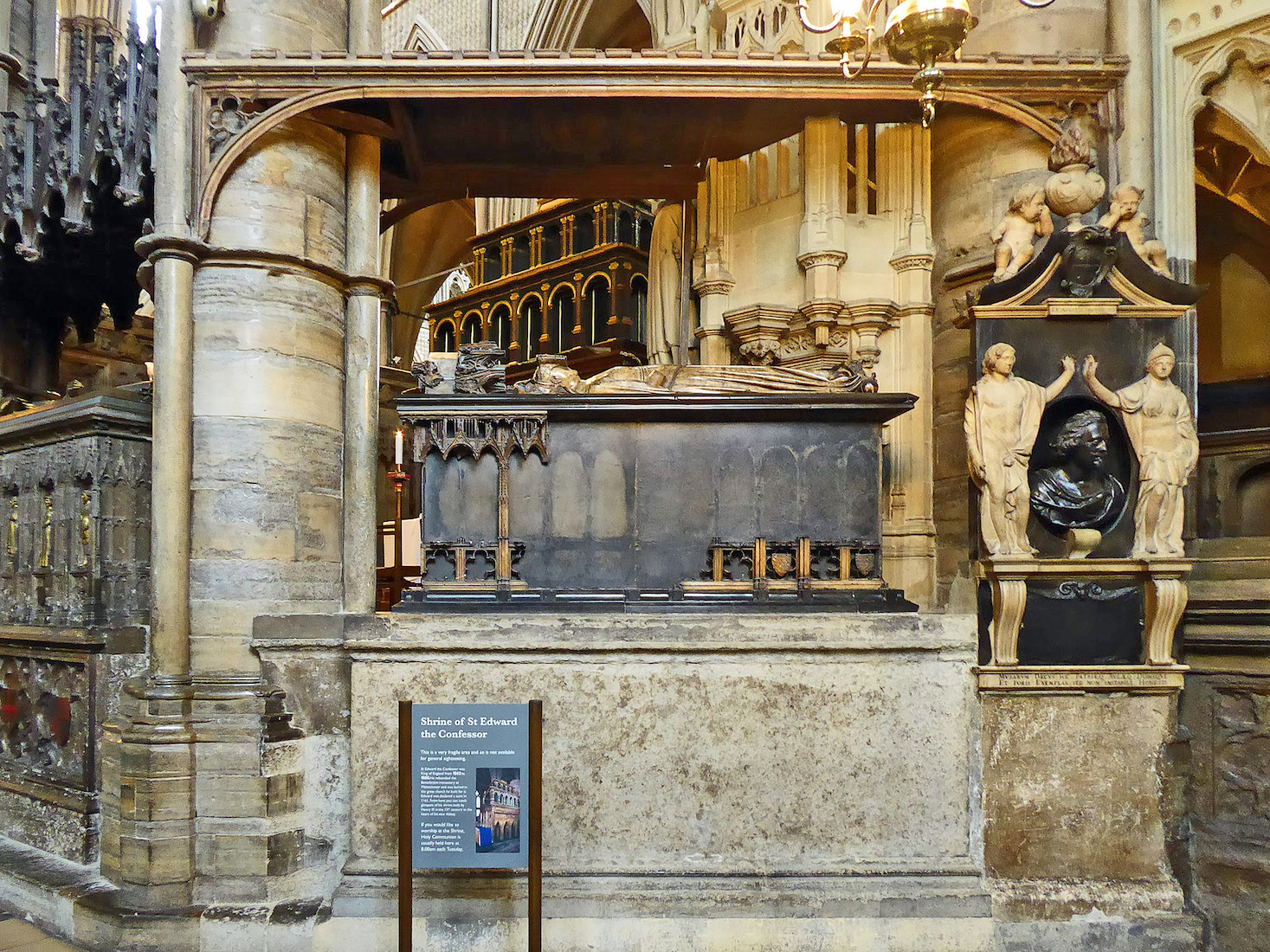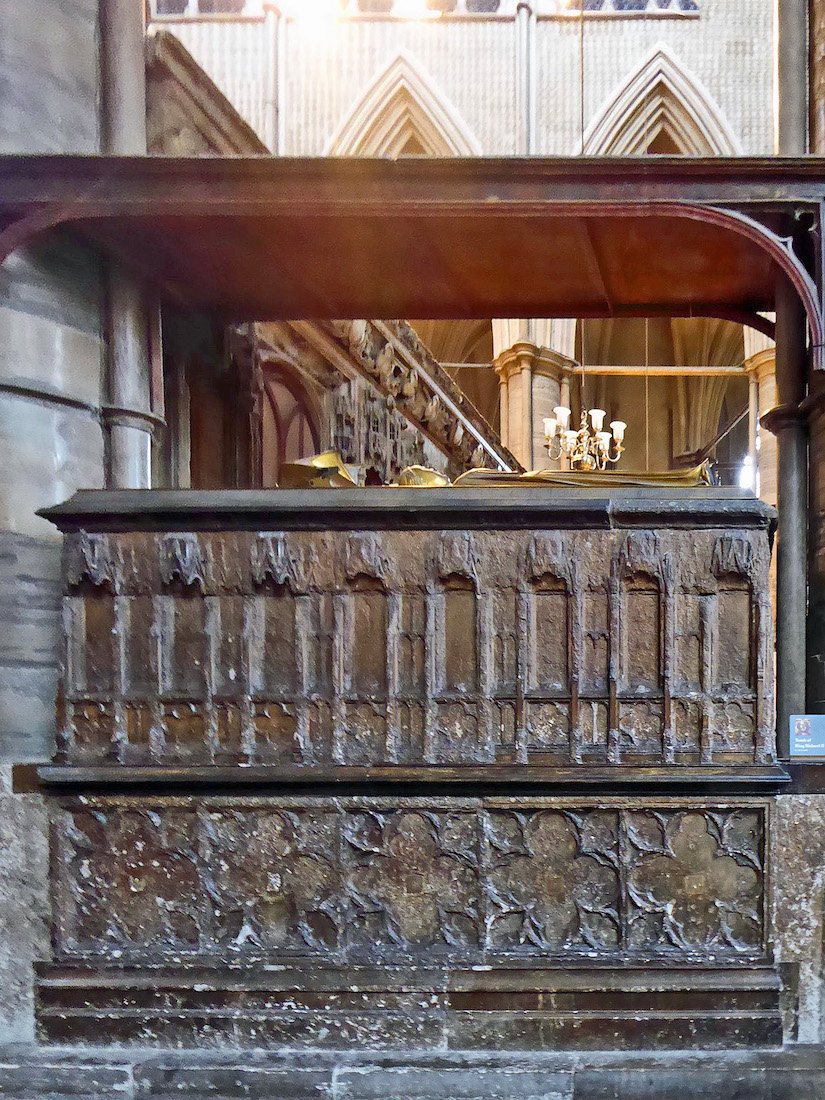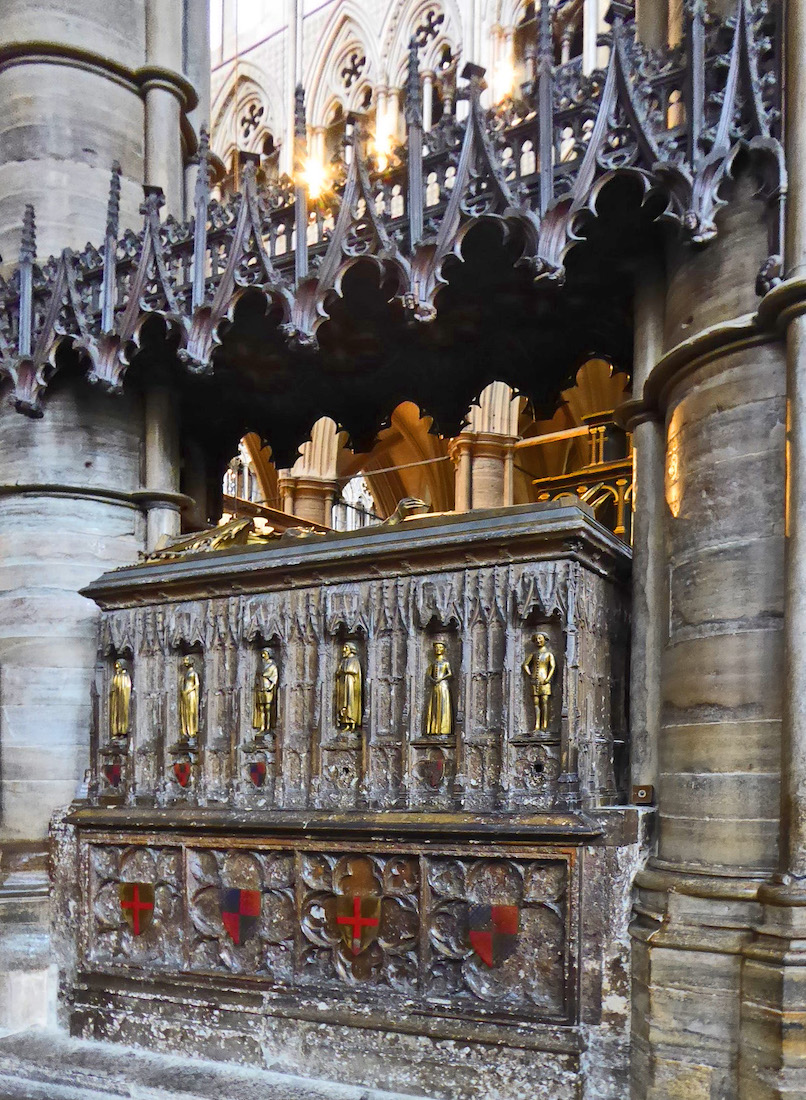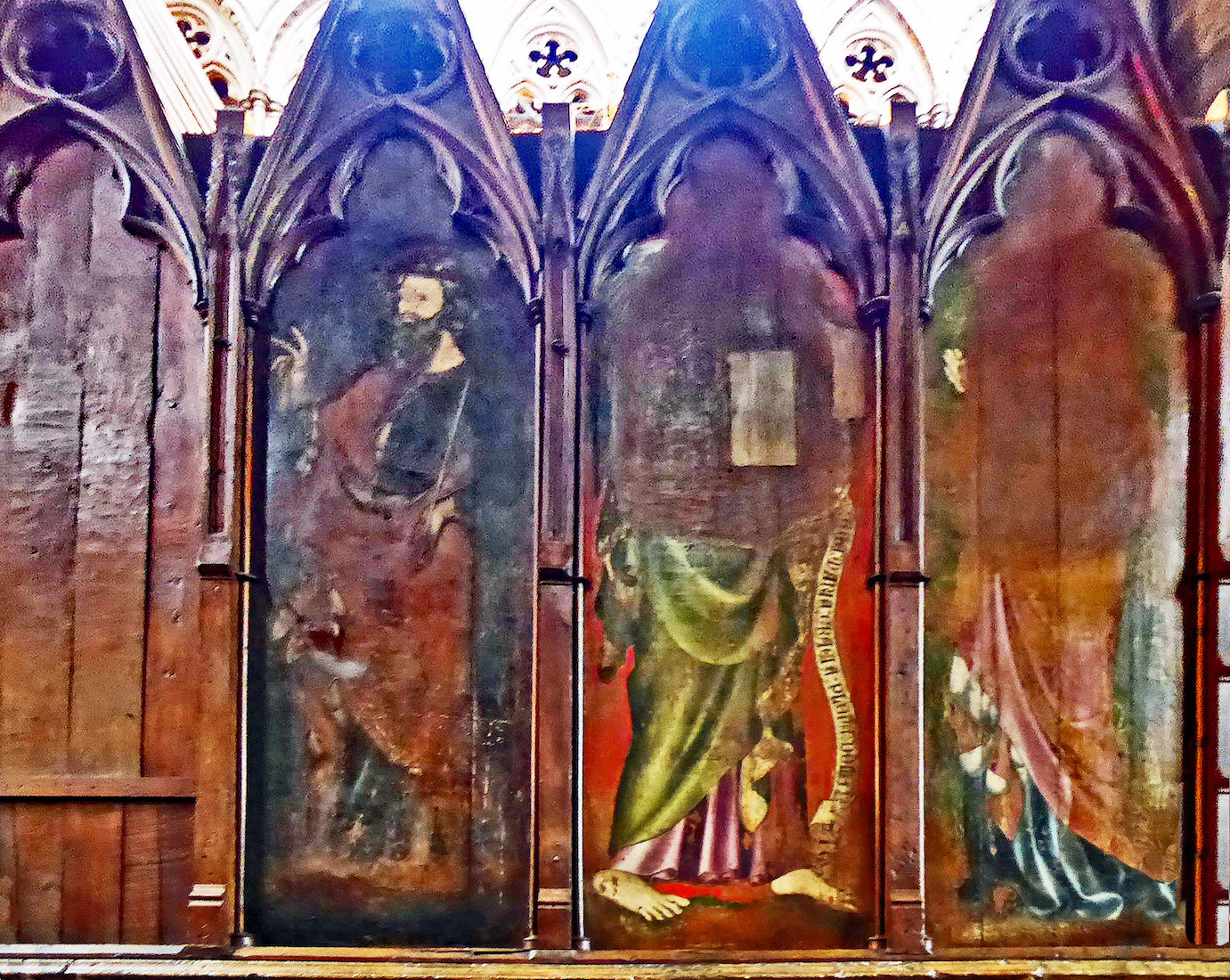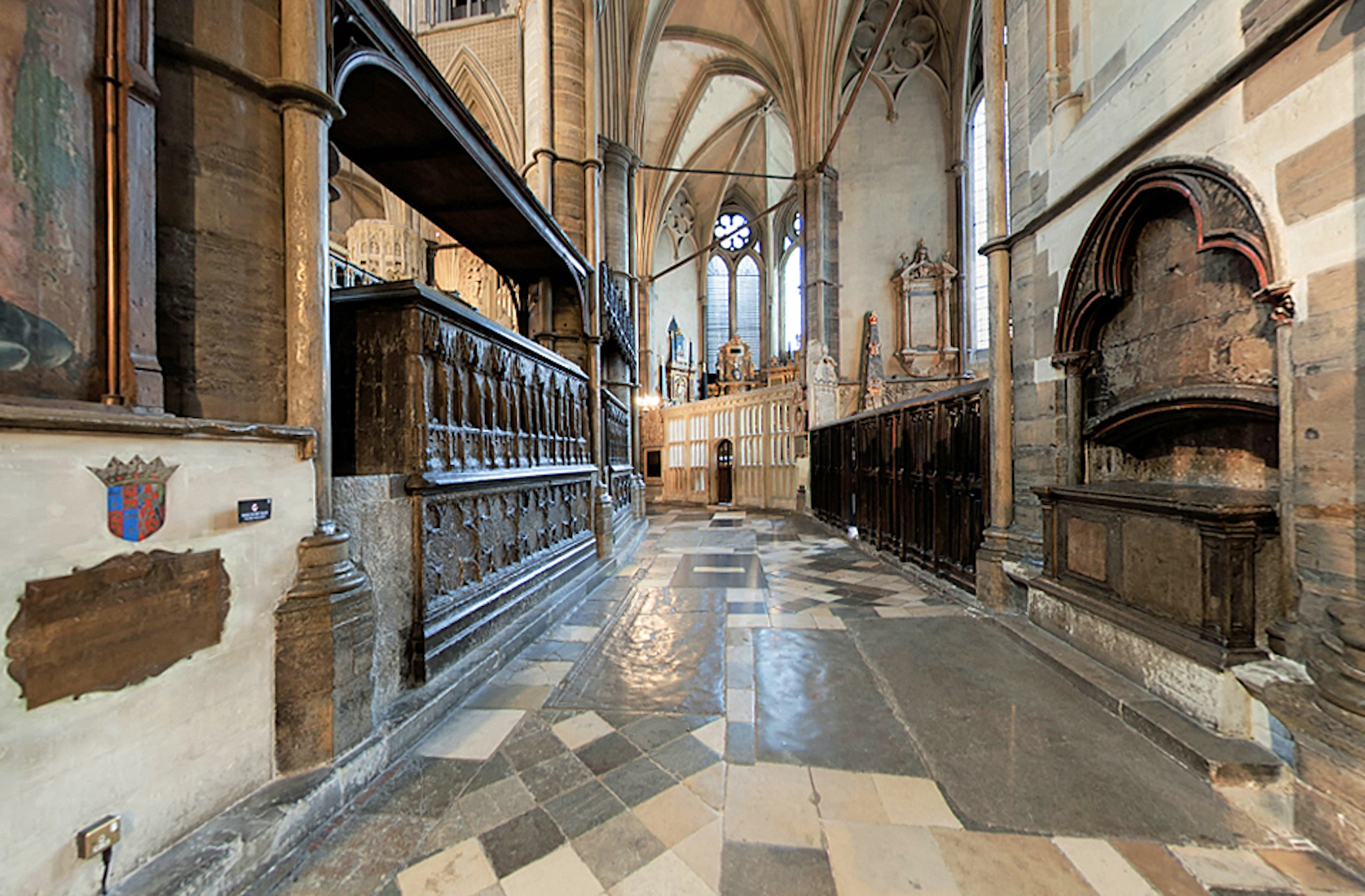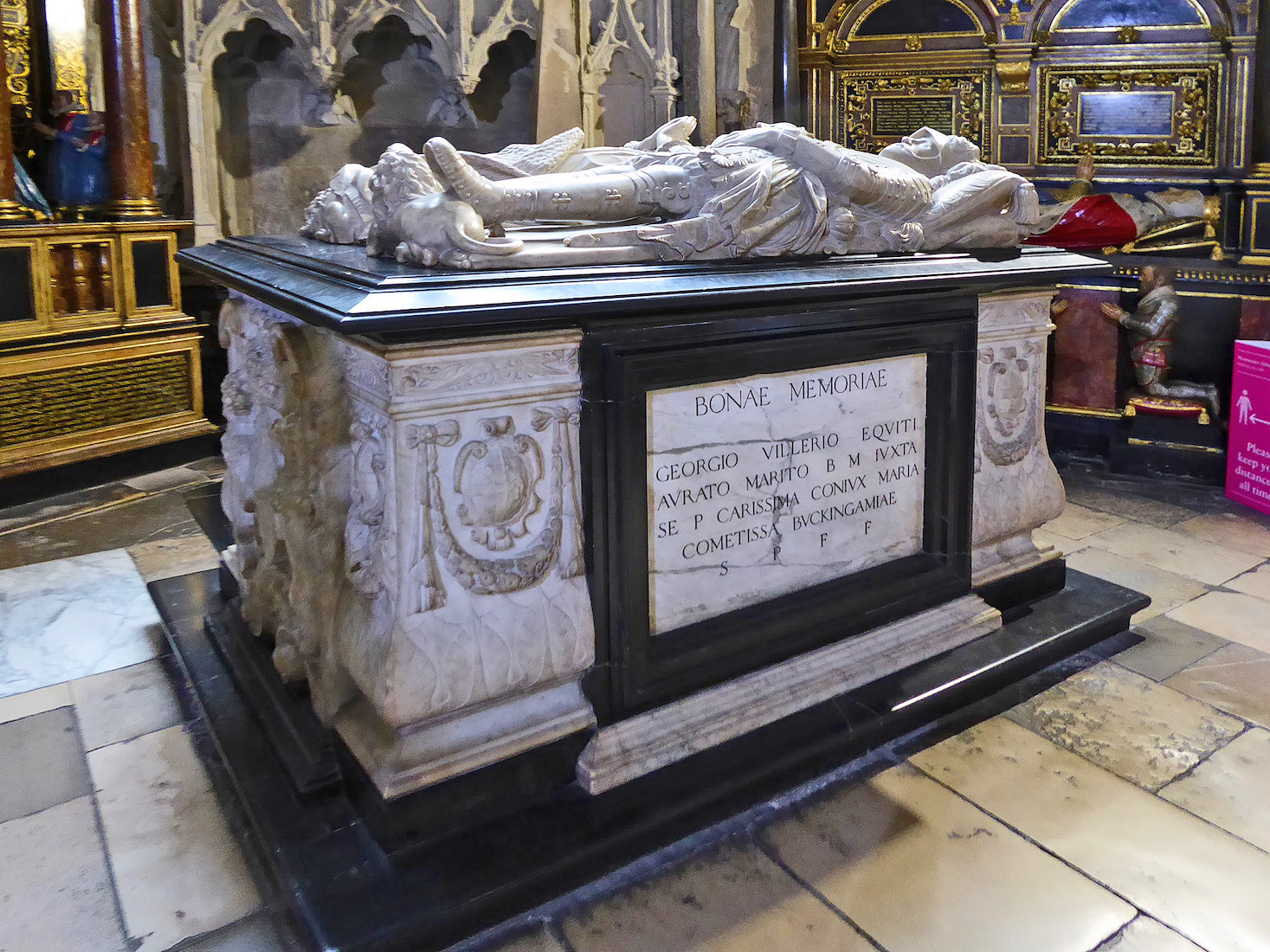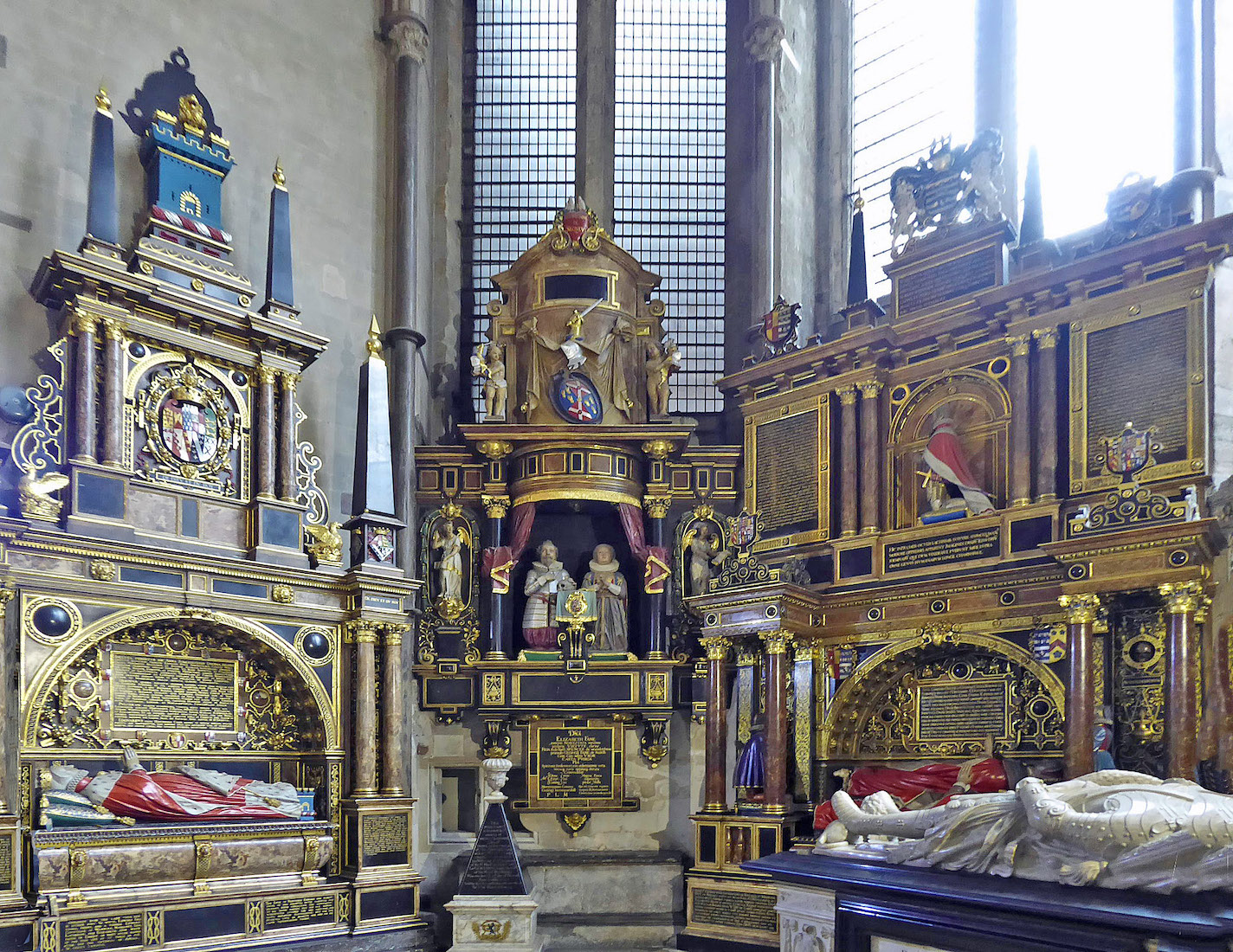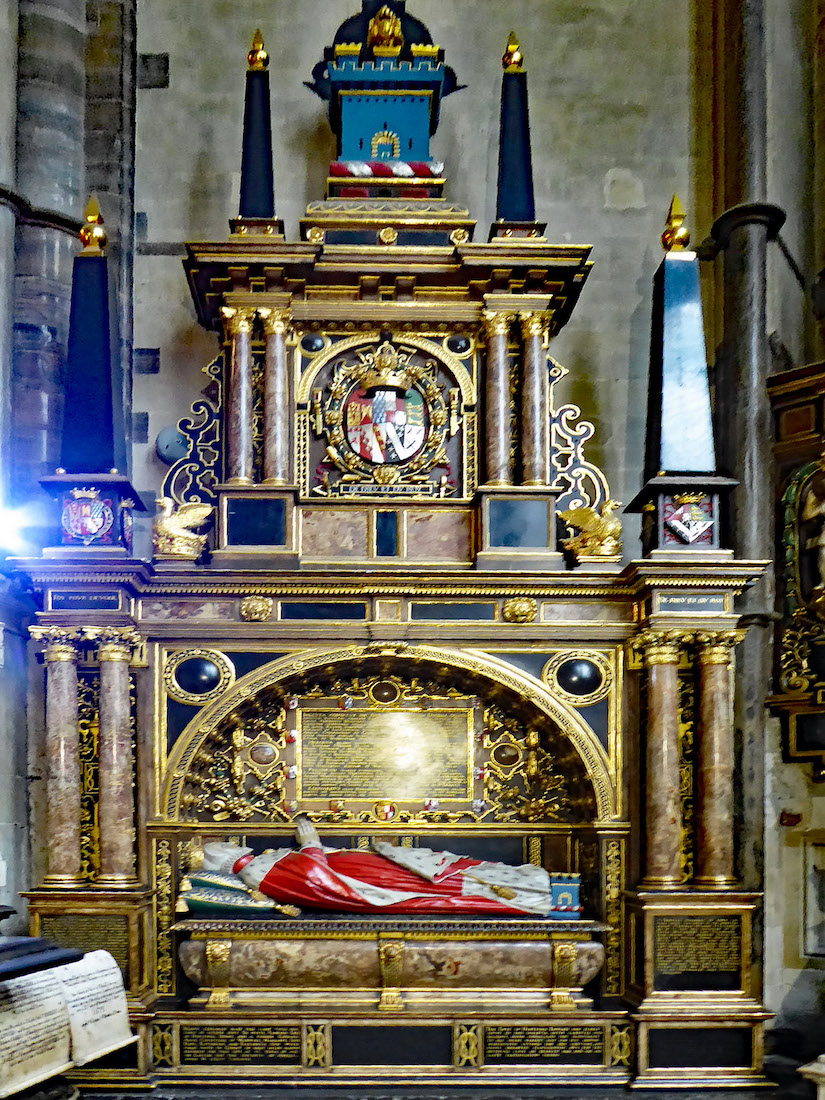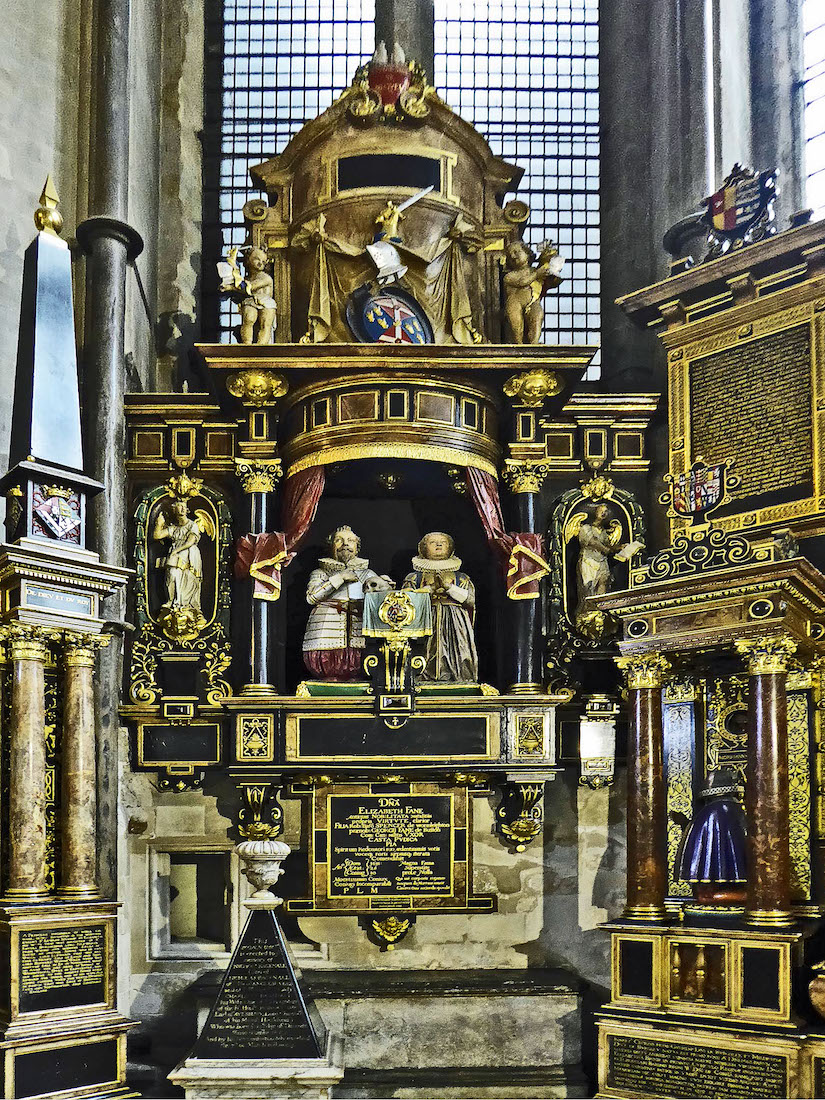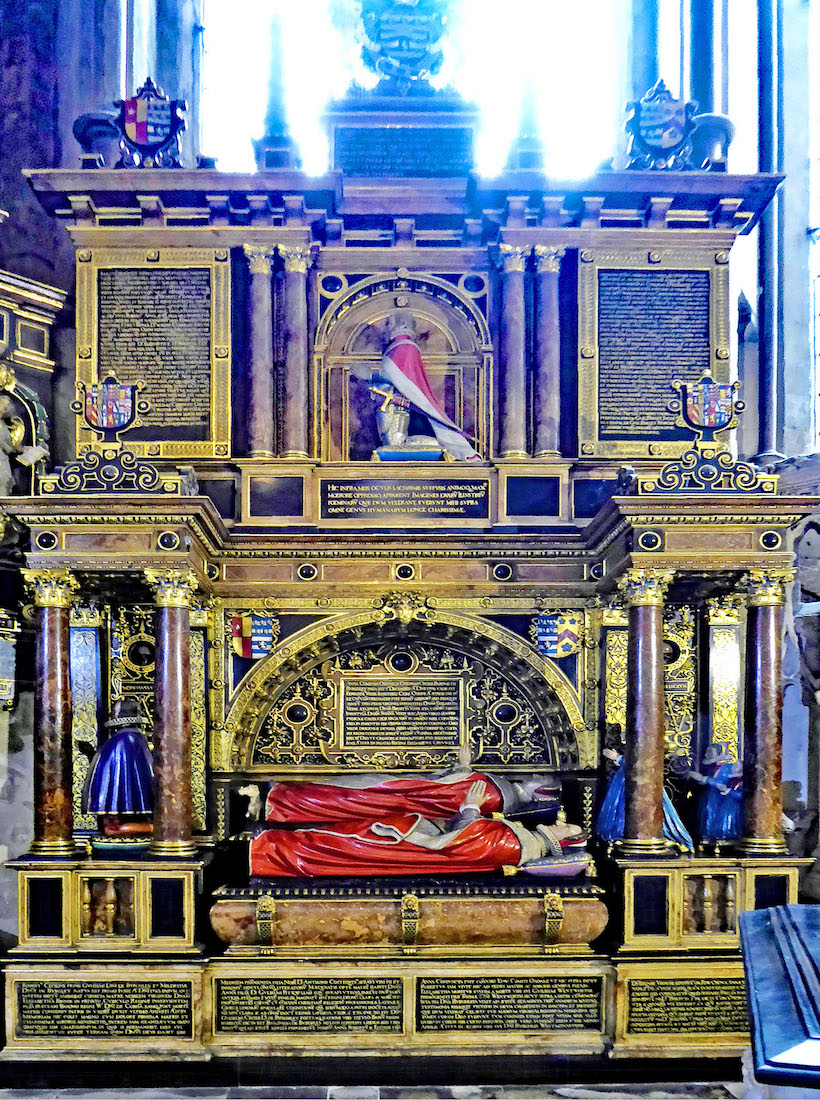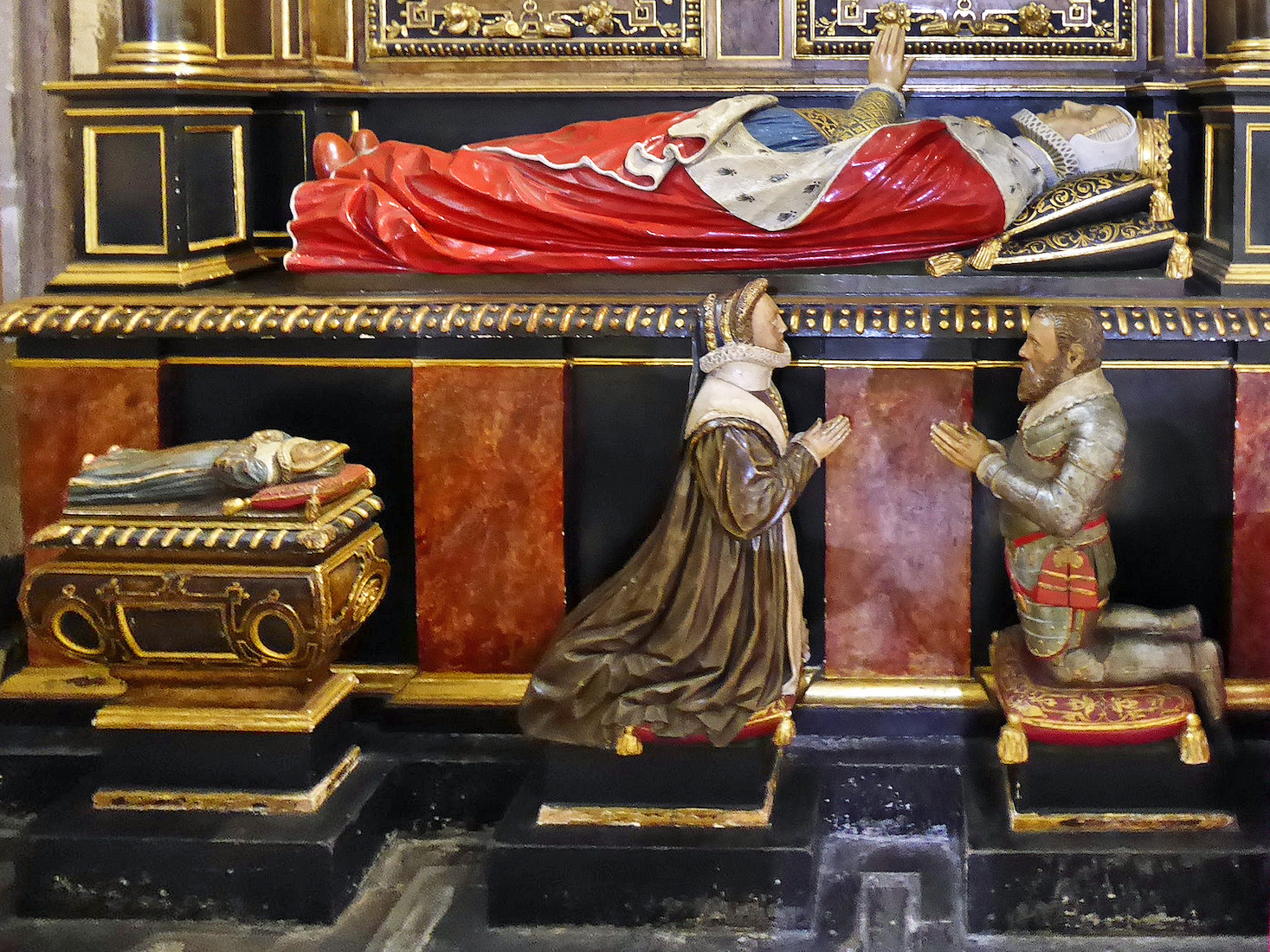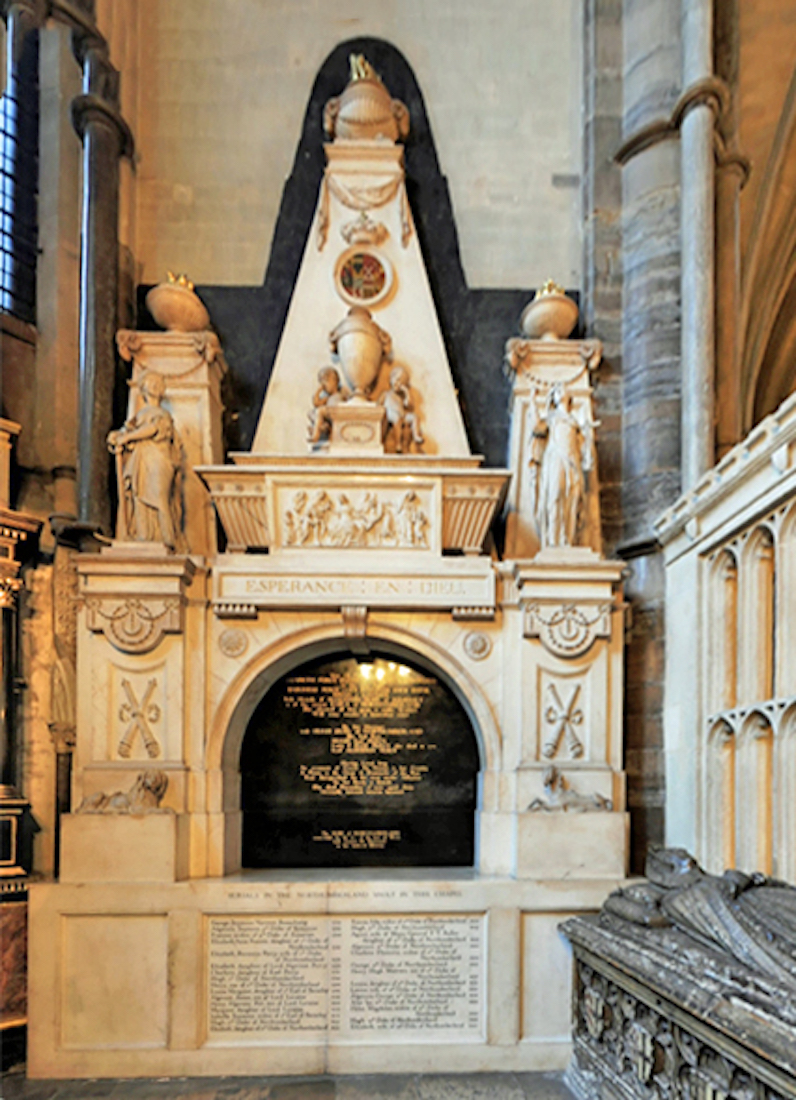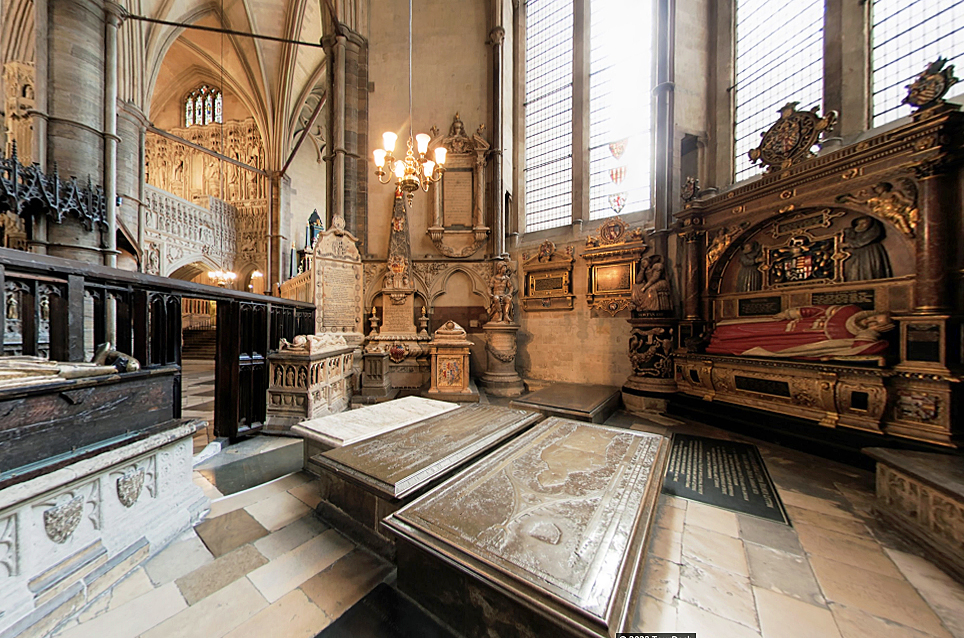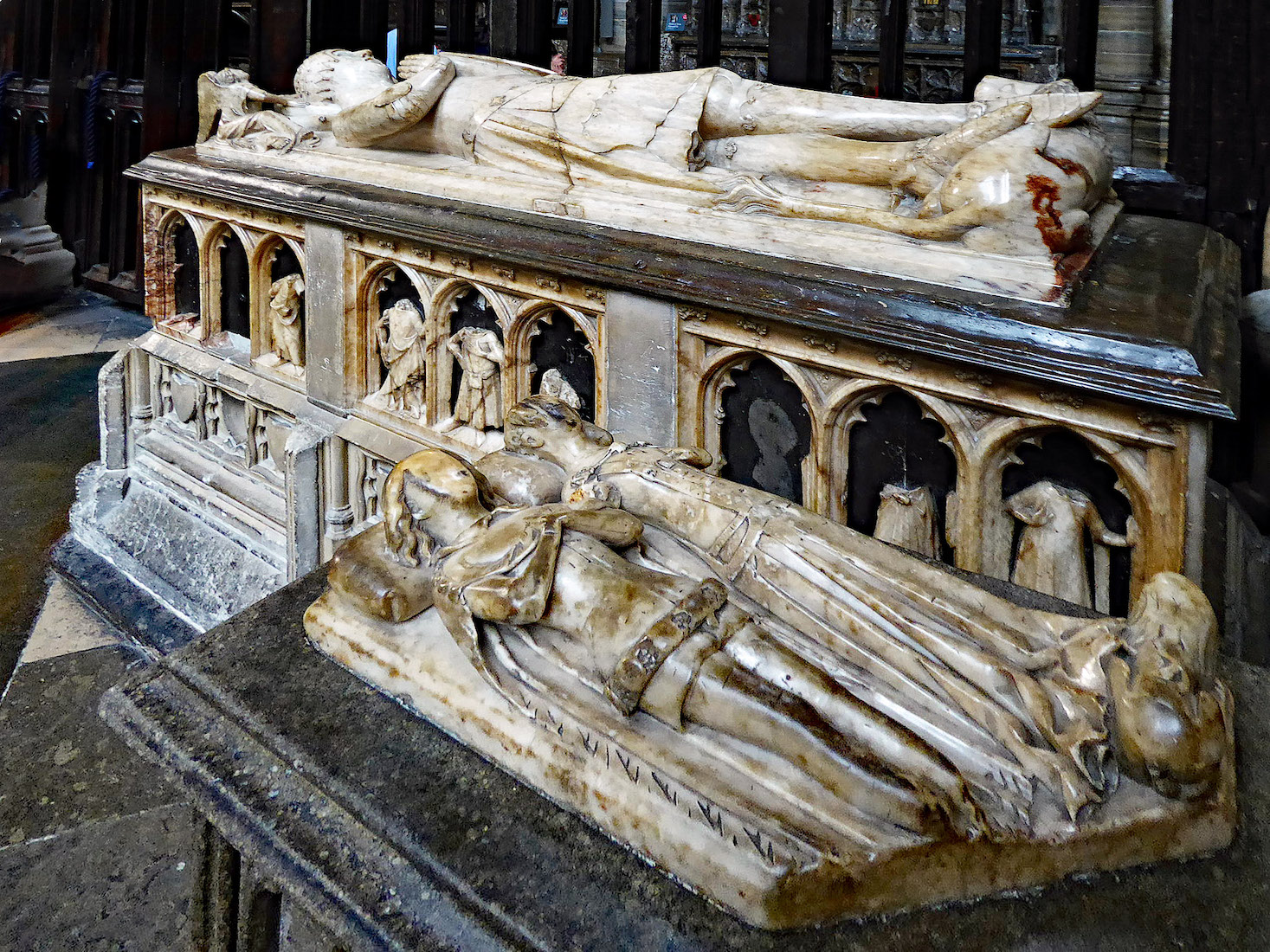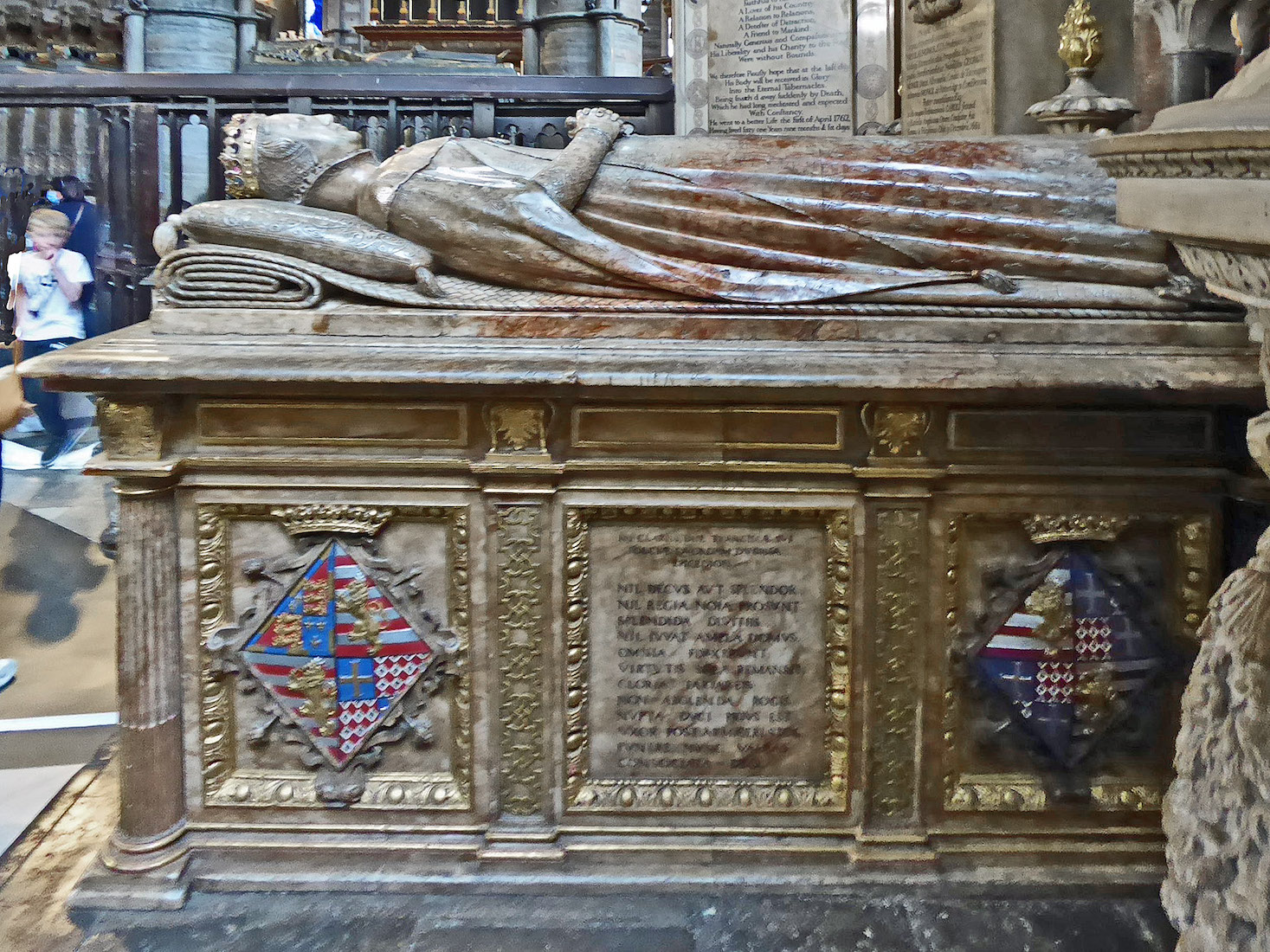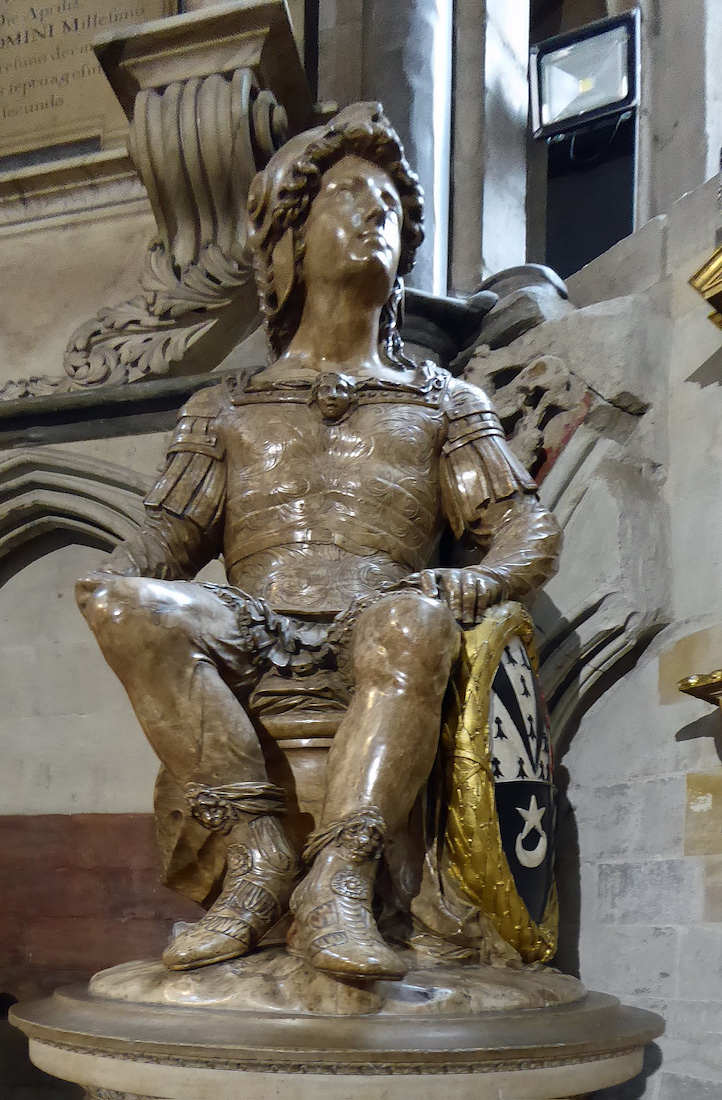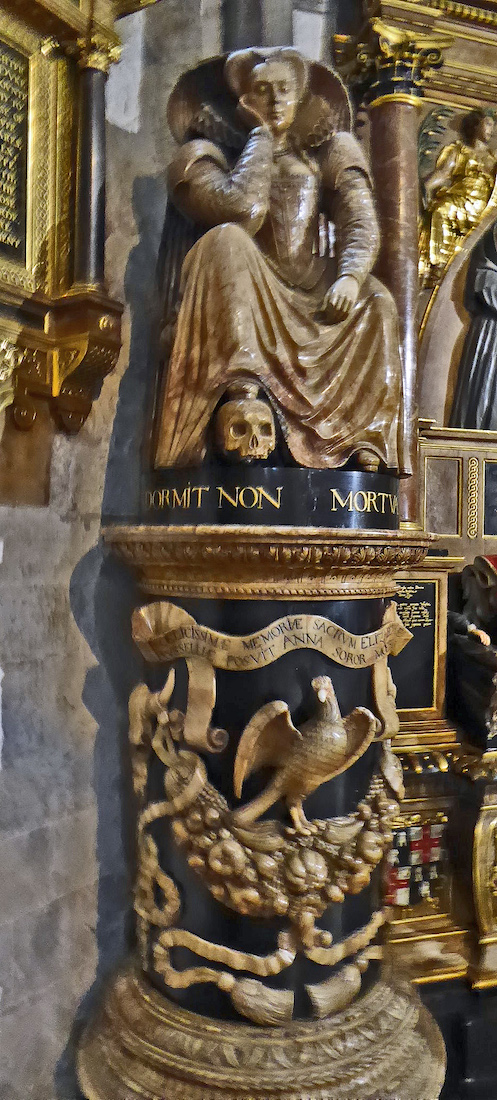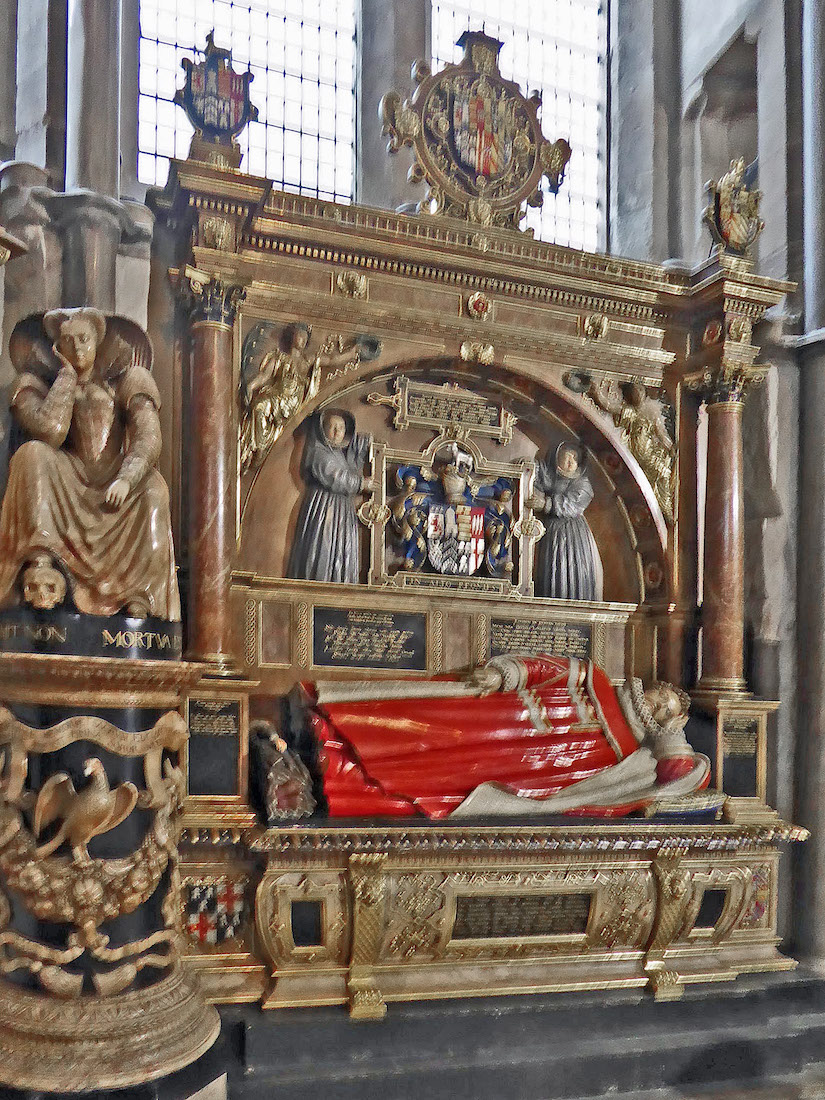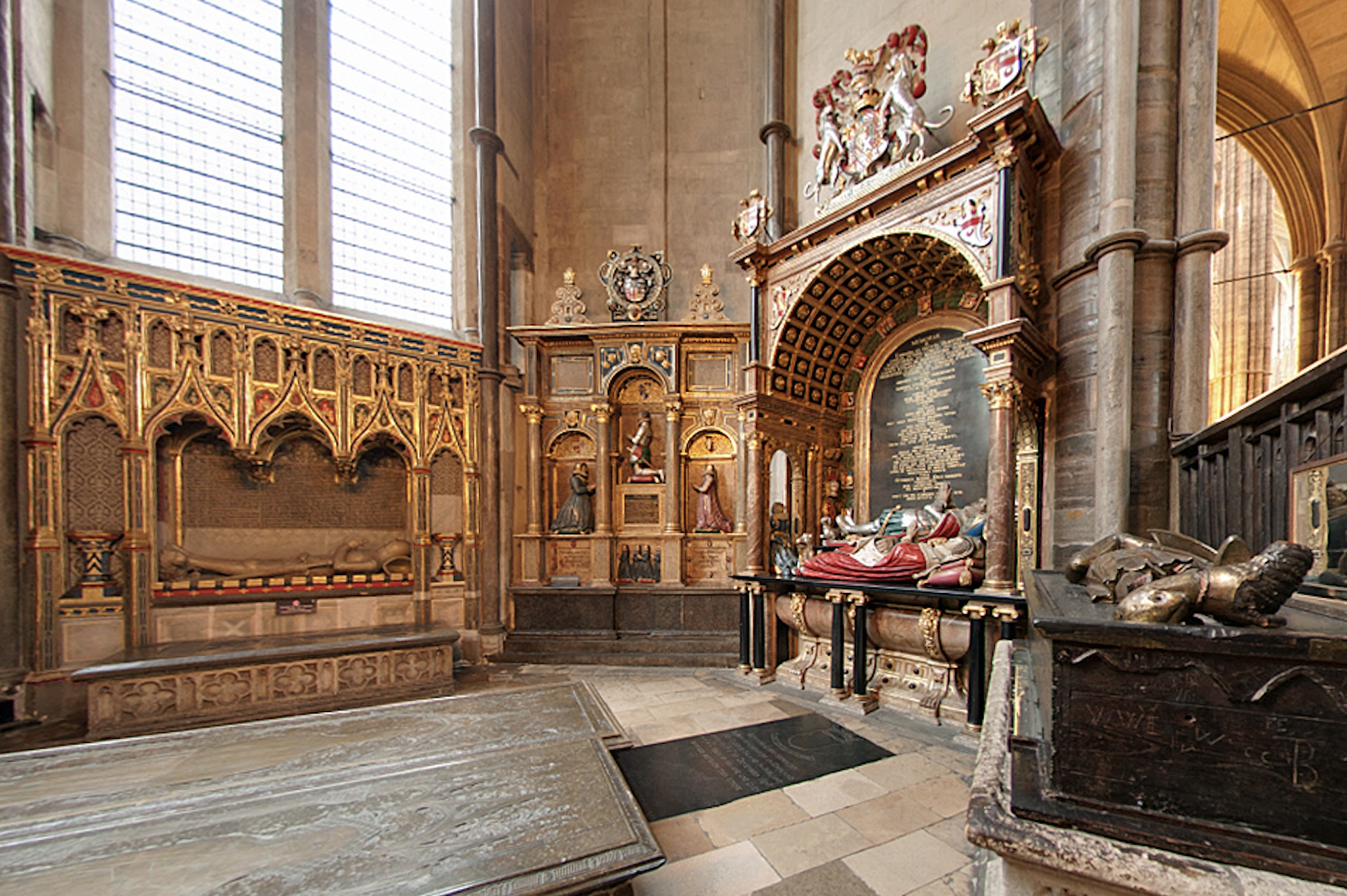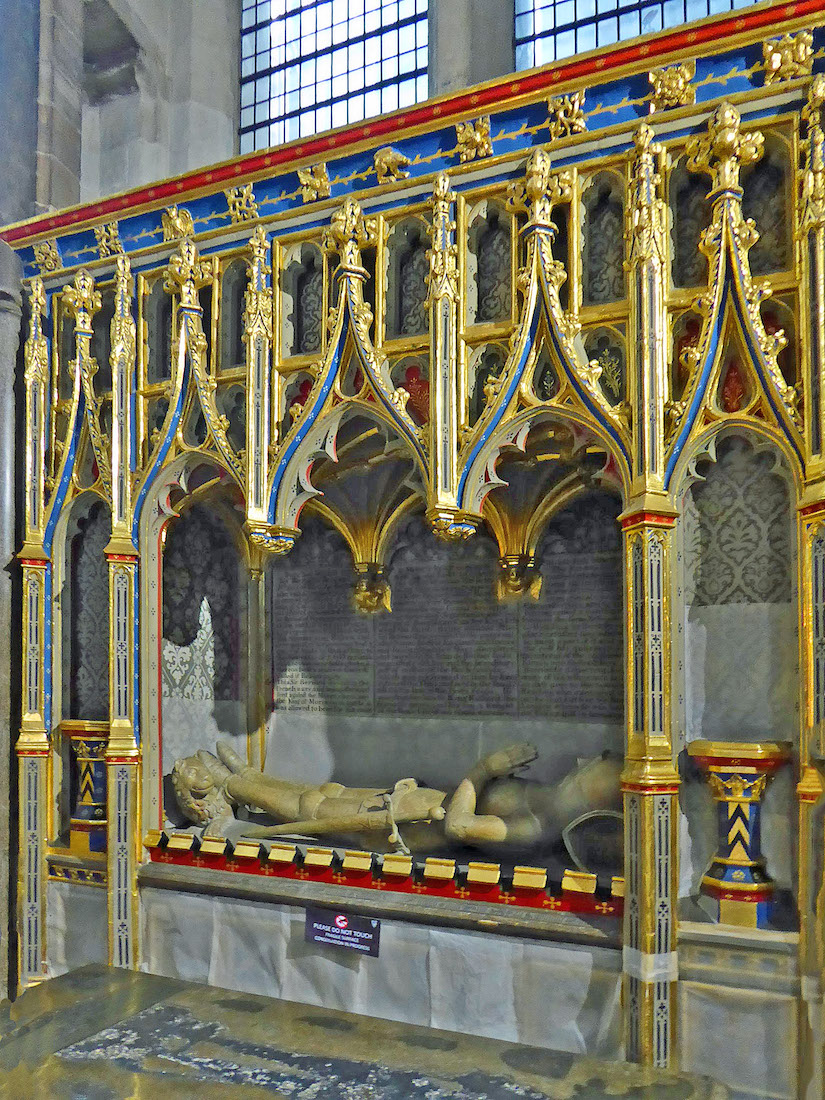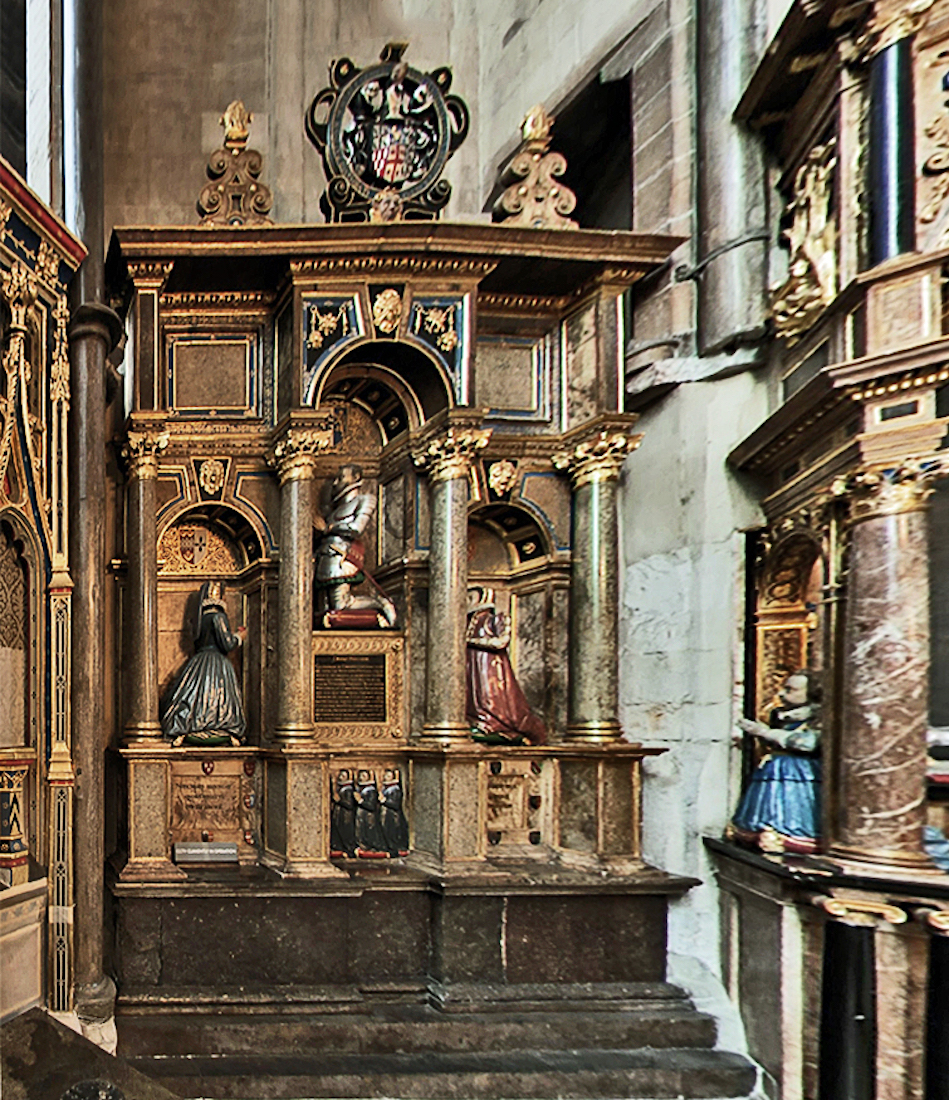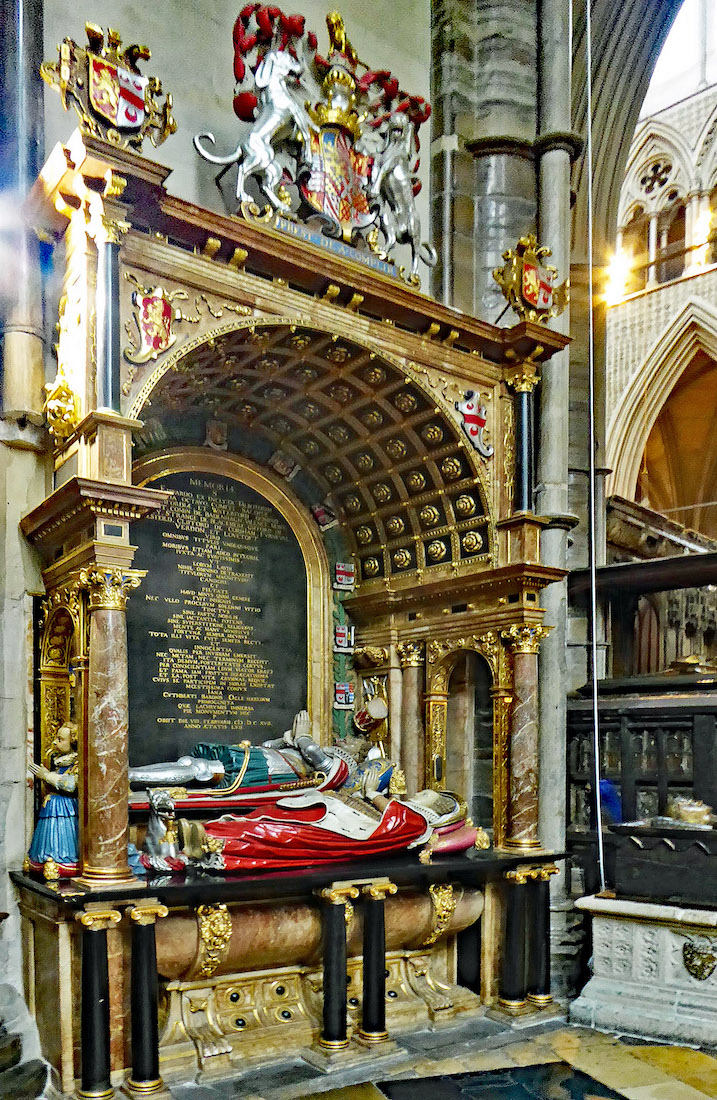F41. HENRY V CHANTRY CARVING AMT AMT
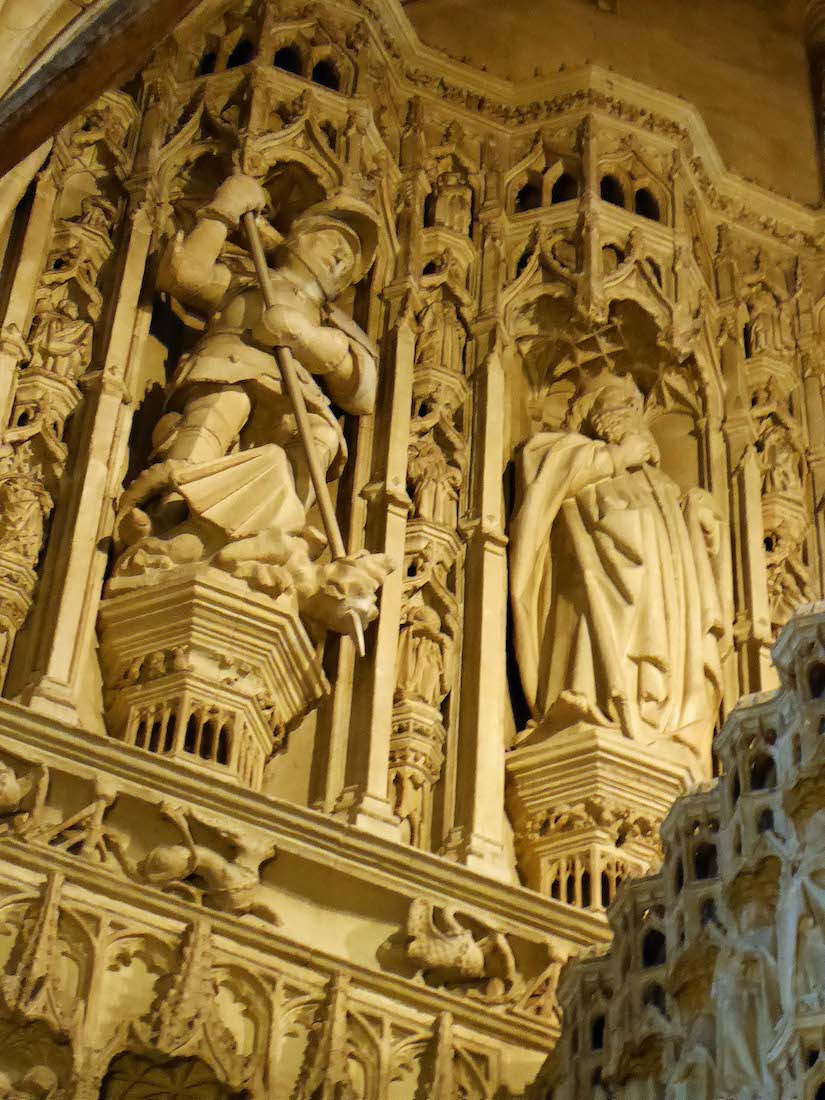
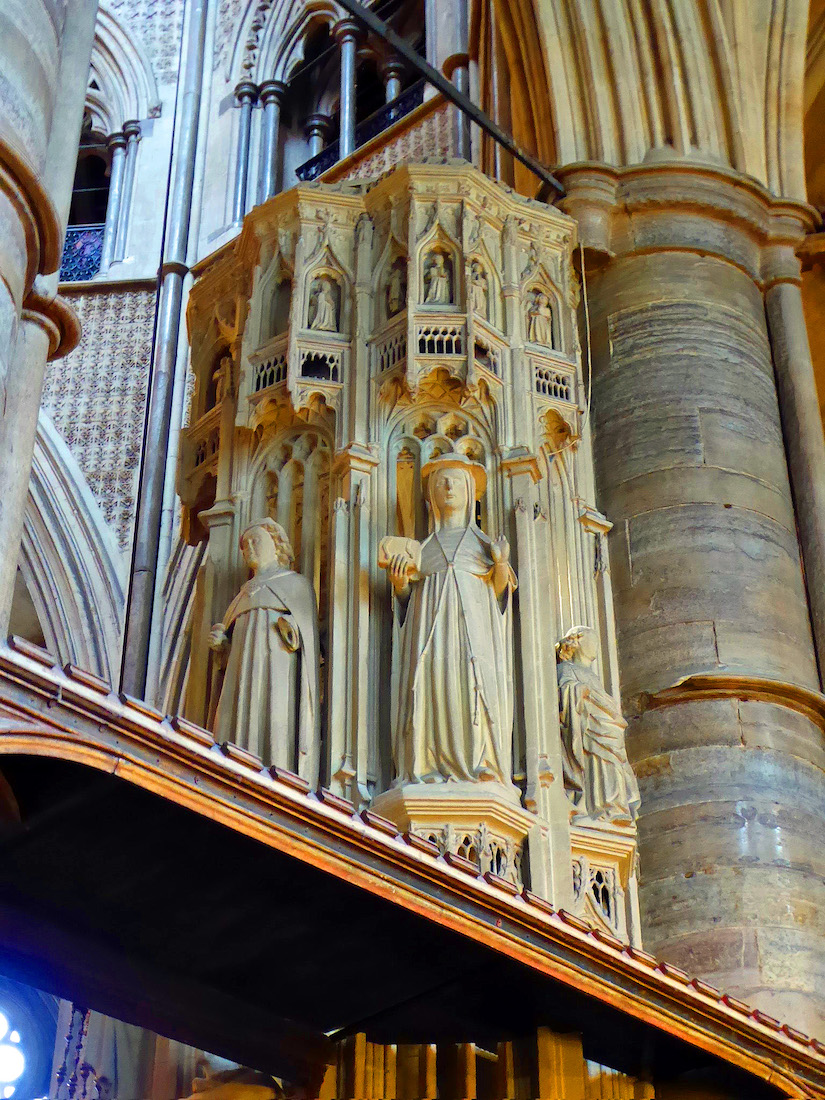
We see here some closer detail of the chantry carving on the North and South sides. INDEX
F42. AMBULATORY TOMBS AMT
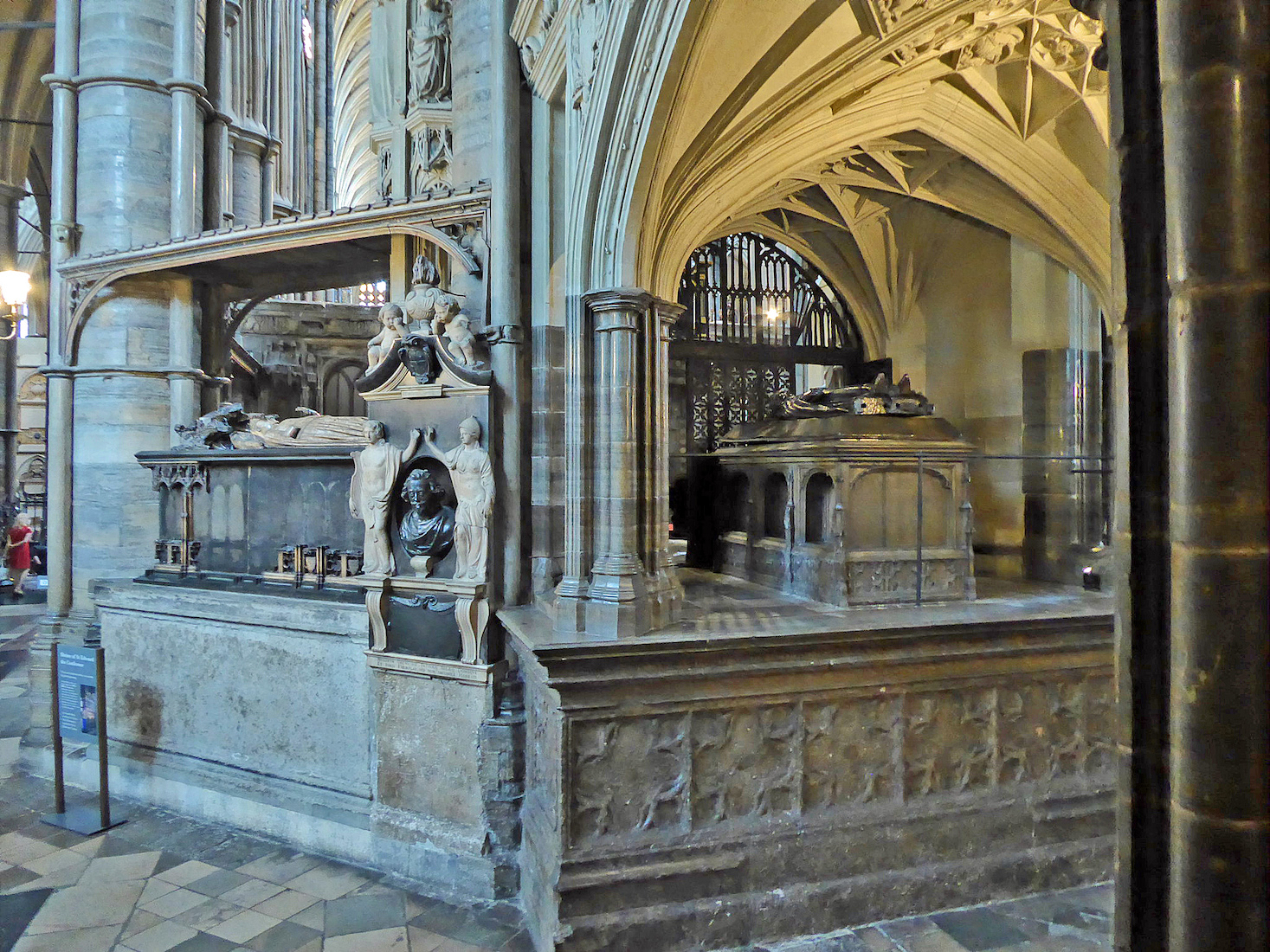
Following around the inner wall of the ambulatory from Queen Eleanor’s tomb, we come to these two tombs. •• The tomb on the right belongs to King Henry V. The King Henry V has an upper and lower section, and this tomb is sited in the lower part. The tomb has long been stripped of its original silver adornments since the time of the Reformation, and had to wait till 1971 to receive a new head and hands. •• The adjacent tomb on the left is that of Queen Philippa of Hainault (d.1369), wife of Edward III. The alabaster effigy was sculpted by Jean de Liege, the tomb chest has sadly been much damaged over time.
F43. SOUTH AMBULATORY: TOMB OF QUEEN PHILIPPA AMT
Edward III, son of Edward II and Isabel, daughter of King Philip of France, was born at Windsor Castle on 13th November 1312 at 5:40am – he was the first English king to have the exact time of his birth recorded. He married Philippa, daughter of William III, Count of Holland and Hainault, at York Minster in 1328. They had seven sons and five daughters (three of whom are buried in the Abbey). Their eldest son Edward of Woodstock, later called the ‘Black’ Prince, probably due to the colour of the armour he wore, died in 1376 and was buried in Canterbury Cathedral.
F44. SOUTH AMBULATORY TOMBS OF KINGS RICHARD II AND EDWARD III AMT AMT
As we follow round the inner wall of the South ambulatory, there are two more tombs – those of Kings Richard II (left) and Edward III (right). •• On Edward’s tomb there were originally bronze weepers (or statuettes) of his twelve children but only six of these now remain on the South side, some with enamelled coats of arms below . Above the tomb is an elaborate wooden tester by Hugh Herland. The arches terminate in half-angels as pendants. •• The rather plain tomb at left is that of Richard III and Anne of Bohemia. Richard was the son of Edward the ‘Black Prince’' (eldest son of King Edward III) and Joan, called the ‘Fair Maid of Kent’. He married Anne, daughter of the Emperor Charles IV of Bohemia, and was devoted to her.
F45. SOUTH AMBULATORY: REAR OF SEDILIA AMT
Following on along this inner wall, we now find ourselves behind the sedilia which we encountered in the sanctuary. The backs of the sedilia have been painted to depict various historical figures, but the images have been badly defaced.
F46. SOUTH AMBULATORY FROM THE WEST AMT
Standing behind the backs of the sedilia (extreme left) we look back along the South ambulatory. Ahead of us is the St Nicholas Chapel, and adjacent to it, behind the black screen is St Edmund’s Chapel We explore these now.
F47. ST NICHOLAS CHAPEL: VILLIERS TOMB AMT AMT
The arrangement of St Nicholas Chapel is much like the previous chapels, with a free-standing chest in the middle, surrounded by walls of monuments. Here, Sir George Villiers and his wife Mary Countess of Buckingham have the central white marble monument with effigies. Mary died on 19th April 1632 and was buried a few days later in the chapel. But although Sir George has an effigy he was actually buried in 1606 at St Denys, Goadby in Leicestershire, near his residence. On the altar chest he is represented partly in plate armour with a plumed helmet, wearing trunk breeches and a sash on which are depicted shells. His feet rest on a lion. His wife has her head on embroidered cushions with cherub head tassels and wears an ermine lined robe, coronet and jewelled necklace with a pendant cross. She has a lion at her feet also.
F48. EASTERN VIEW AMT
Looking East from the entry to the St Nicholas Chapel, we see the Duchess of Somerset and Fane memorials.
F49. DUCHESS OF SOMERSET AND FANE MONUMENTS AMT AMT
Anne Stanhope, Duchess of Somerset is buried in this chapel and has a large monument here (shown left). This is mainly of alabaster with an effigy of the Duchess in a red ermine-lined robe wearing a coronet. At her feet is the crest of a blue triple-towered castle, from the Stanhope coat of arms. •• Next on the right is the Fane monument – a large elaborate monument of alabaster and marble to Elizabeth Fane (d.1618). The Latin inscription can be translated: ‘The Lady Elizabeth Fane, remarkable for her ancient descent, but more for her own virtue, daughter of Robert, Baron Spencer of Wormleighton, and wife to the honourable Sir George Fane, of Burston in the county of Kent, Knight. A chaste, modest and religious wife, who in most ardent ejaculations, frequently repeated, with a loud voice, recommended her soul to her Redeemer ... .’ (!)
F50. CECIL AND WINIFRED TOMBS AMT AMT
Following around the walls of the St Nicholas Chapel, we come to these two monuments. •• At left is the tomb of Mildred Cecil, Lady Burghley (d.1589) and her daughter Anne, Countess of Oxford (d.1588). It is one of the largest monuments in the Abbey and has been attributed to sculptor Cornelius Cure. •• Next to it at right is a large monument to Winifred, Marchioness of Winchester. It is attributed to sculptor Garrett Johnson and shows an effigy of Winifred, confusingly dressed in a red, ermine-lined mantle wearing a gilt coronet. The main tomb is of alabaster and marble with columns and a lozenge of her coat of arms. In front, on pedestals, kneeling on red cushions, are her son Thomas Sackville, Lord Buckhurst (later 1st Earl of Dorset), the poet, and her daughter Anne, who married Gregory Fiennes, Lord Dacre. There is also a figure of a baby girl on a small sarcophagus, being a child who obviously died in infancy.
F51. DUCHESS OF NORTHUMBERLAND TOMB GSV AMT
We come to a large monument to Winifred, Marchioness of Winchester. It is attributed to sculptor Garrett Johnson and shows an effigy of Winifred in a red, ermine-lined mantle wearing a gilt coronet. The main tomb is of alabaster and marble with columns and a lozenge of her coat of arms. In front, on pedestals, kneeling on red cushions, are her son Thomas Sackville, Lord Buckhurst (later 1st Earl of Dorset), the poet, and her daughter Anne, who married Gregory Fiennes, Lord Dacre. There is also a figure of a baby girl on a small sarcophagus, being a child who obviously died in infancy. •• Philippa Mohun was buried in St Nicholas' chapel in Westminster Abbey. Her altar tomb of freestone was originally in the centre of the chapel but was moved (prior to 1600) to the north west corner. Her effigy is shown in a long cloak and widow's hood, her head on two cushions. There are traces of paint on the effigy but the hands have been broken off. Around the tomb base are seven shields, but there may be more hidden on the side which is against the chapel screen.
F52. VIEW ACROSS St EDMUND’S CHAPEL AMT
The next chapel, as we follow around the ambulatory, is St Edmund’s Chapel. This is the view looking east. We can see the South side of Henry VII’s chantry arch looking back through the Chapel entry. As we explore East of the entry we shall notice particularly the three tombs, the obelisk monument, and the two seated figures.
F53. TOMBS IN ST EDMUND’S CHAPEL AMT
The larger tomb here is that of John of Eltham. The embalmed body of Prince John of Eltham was buried in Westminster Abbey on 13th January 1337. He was born at Eltham manor in Kent in August 1316 and took his surname from his birthplace. He was the second son of King Edward II (d.1327) and his wife Queen Isabella of France (d.1358). In 1328 John was created Earl of Cornwall by his elder brother King Edward III. Beside John’s monument is a small tomb with miniature effigies of William of Windsor and Blanche, children of Edward III. This has no inscription.
F54. BRANDON TOMB AMT
The next tomb in line is of Frances Brandon. Frances Brandon (1517 – 1545), Duchess of Suffolk was buried in St Edmund’s chapel in Westminster Abbey. She was the elder daughter of Charles Brandon, Duke of Suffolk (d.1545) and his third wife Mary Tudor (d.1533), sister of King Henry VIII and widow of King Louis XII of France.
F55. HOLLES AND RUSSELL MONUMENTS AMT AMT
We come next to two seated figures. •• Francis Holles was buried in the chapel of St Edmund. He has a free standing monument, by sculptor Nicholas Stone, consisting of a stone circular pedestal with festoons of flowers upon which Francis is depicted as a life-size seated figure in Roman armour, his left hand resting on an oval armorial shield. He died aged 18 in 1622 after a campaign in the Netherlands. •• At right is Elizabeth Russell (D. 1601). She was the wife of Lord John Russell whose tomb we come to next.
F56. RUSSELL MONUMENT AMT
Prime Minister 1846-1852 and again after Lord Palmerston's death in 1865-1866. He had served as Foreign Secretary under Palmerston and was created Earl Russell in 1861. In 1866 when his party was defeated he resigned. He was buried in the family vault at Chenies manor in Buckinghamshire.
F57. MONUMENTS IN ST EDMUND’S CHAPEL AMT
Here is an overview of the remaining monuments in St Edmund’s Chapel. From left we have: the Borcas tomb, the Pecksall monument, the Talbot tomb, and the William de Valance tomb.
F58. BROCAS TOMB AMT
This is the tomb of Sir Bernard Brocas (1330?-1395). His family originally came from Gascony in France, where they fought for the English cause. Brocas was a favourite knight of Edward the ‘Black Prince’, son of Edward III, and was present at the battles of Poitiers and Crecy.
F59. PECKSALL MONUMENT AMT
In the chapel of St Edmund is a large alabaster and marble monument to Sir Richard Pecksall (d.1571), Master of the Royal Buckhounds, a post he inherited from the Brocas family. The monument consists of arched recesses with columns and many small shields on an older Purbeck marble base. A figure of Richard kneels in the centre recess flanked by kneeling figures of his two wives. Below are small kneeling figures of four daughters by his first wife. The monument was re-painted in the late 1950s.
F60. TALBOT TOMB AMT
Edward Talbot, 8th Earl of Shrewsbury, was buried in St Edmund’s chapel. Edward was Member of Parliament for Northumberland and member of the Council of Wales. He died in 1618. His wife Jane erected this large monument for him, which is by the sculptor William Wright


